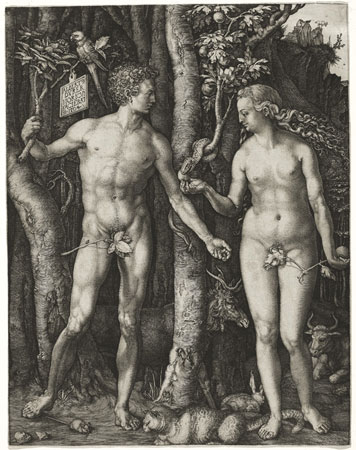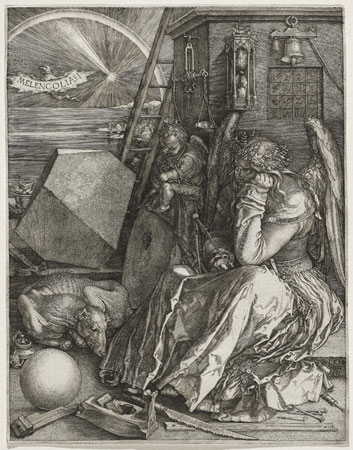Previous: Face the Nation (161)
Works of a Renaissance Master: The Prints of Albrecht Dürer
Post #1230 • September 16, 2008, 11:11 AM • 35 Comments
Edmonton, AB - Albrecht Dürer's superpowers as a draughtsman are in evidence throughout his work, but prints, in particular, preserved his prodigious ability to translate imagination into two dimensions. Works of a Renaissance Master: The Prints of Albrecht Dürer is a fortunate and enjoyable opportunity to witness his printmaking in action. The exhibition lavishes particular attention on Melancholia, carefully going over symbolism in the original engraving with a legend marked on a copy enlarged to the size of a display window. It degrades hardly at all thanks to Dürer's skill with the tools. He could depict a whole hill-town, down to the turrets, on two square inches of paper. A sense of the Medieval never fully departed the work of the Northern Renaissance, and that, coupled with the artist's millimeter-by-millimeter craftsmanship, ends up making the woodcuts a bit noisy. But the engravings, especially the famed Adam and Eve, are technically superlative, and crowded with little jewels of artistic flourish and intriguing images. Saints fly, animals lurk, haloed human limbs proclaim the Revelations, and nude embodiments of various virtues walk astride clouds.
Something of a de facto futures market formed at the front desk of the AGA. I was kindly offered, twice, a free poster for Face the Nation, also showing at the museum. I declined, but inquired about one for the Dürer show. That one was $3. It now graces the RV, where I can reflect on Dürer's mastery and the qualities that inspire one to value a thing.

Albrecht Dürer: The Virgin and Child with the Monkey, c. 1498, National Gallery of Canada, Ottawa, photo © NGC

Albrecht Dürer, The Four Horsemen, c. 1496-1498, National Gallery of Canada, Ottawa, photo © NGC

Albrecht Dürer: Adam and Eve, 1504, National Gallery of Canada, Ottawa, photo © NGC

Albrecht Dürer: Melancholia, 1514, National Gallery of Canada, Ottawa, photo © NGC

Albrecht Dürer: St. Anthony, 1519, National Gallery of Canada, Ottawa, photo © NGC
2.
September 16, 2008, 9:24 AM
'the qualities that inspire one to value a thing.'
Of course this is the real matter at hand. Mr. Durer made his work so glaringly good that most wouldn't miss these qualities, at least until ARTMART peaked and was finally franchised. Now, a visit to the museum is more like a birthday party at Chuck E. Cheese. Sounds like sometimes there's even free loot...depending on whose party you get invited to I guess.
3.
September 16, 2008, 9:27 AM
yeah, i think they call that trend modernism, dude.
4.
September 16, 2008, 9:44 AM
Don't worry Snide. There's lots of job opportunities at ARTMART. I'm sure you've started your slither to the top. Hell, we're in the Meaning business after all. It's a booming market. No shortage of raw material and labour costs must be next to nothing. At least it would seem so based on the work.
For the record, nothing you've ever written tells me you know jack shit about modernism...what it is, or why we care to talk about it here or elsewhere. You've dropped loaded insensitive misunderstanding that reeks of an agenda and nothing more.
5.
September 16, 2008, 9:55 AM
Is it me, or does it look like Adam is about to pinch Eve's coochie?
6.
September 16, 2008, 2:09 PM
[No ads. Read the guidelines. - F.]
7.
September 16, 2008, 4:13 PM
Yes Ben, welcome to the Thunderdome.
8.
September 16, 2008, 4:21 PM
Thanks for sharing your web link with us, Ben. That is quite the site you've got there... I think my favorite part is this:
"This is an example of a WordPress page, you could edit this to put information about yourself or your site so readers know where you are coming from. You can create as many pages like this one or sub-pages as you like and manage all of your content inside of WordPress."
I'll be sure to add you to my bookmarks...
9.
September 16, 2008, 5:30 PM
"St. Anthony" was my favourite first!
10.
September 16, 2008, 5:42 PM
In his time, Durer was more famous as a graphic artist than as a painter. Erasmus called him "the Apelles of black lines" (Apelles being a legendary ancient Greek painter).
He visited Venice twice, and on his second trip found that his prints were being skillfully copied (without permission, of course) by Marcantonio Raimondi, who became the most important Italian engraver of the Renaissance. Durer apparently took Raimondi before the Venetian Senate for plagiarism and won his case, supposedly the first instance of copyright infringement litigation in art history.
Raimondi pioneered the use of engraving to reproduce the work of other artists. He was closely associated in Rome with Raphael, and his prints after the latter disseminated the Italian High Renaissance style throughout Europe.
11.
September 16, 2008, 6:30 PM
it is one of those, they all feel the same, yet different moments. all freaky great though.
nice comment jack.
12.
September 16, 2008, 6:46 PM
"St. Anthony" wasn't the smallest thing in the exhibit, but it was little. Maybe only four inches wide? Nah, looking at the digimage above, it had to be bigger than that. Maybe only four inches in intimatometers.
13.
September 16, 2008, 7:39 PM
Although not directly related to this posting, below is a quote I find to be relevant to the last few posts and many before that. It was posted today, September 16, by Enrique Martínez Celaya on his blog.
"Spin Paintings
In contrast to the perspective offered by distance, our daily living favors the immediate and the fashionable, and sometimes persuaded by that immediacy as well as by cultural repetition and the desire to seem informed, people praise the artistic merit of dubious artworks, and moral flexibility and status anxiety encourage these colorful evaluations.
On September 15, 2008, the same day the Stock Market lost more than 500 points, partly as a result of the whimsical investments in the financial field gone bad, more than 200 pieces of new work by Damien Hirst sold through Sotheby's for more than 200 million dollars. The offering of pickled animals, butterflies and dots, which were made by the more than 180 people who work for Hirst, was the first time an artist used an auction house to sell new work. Hirst’s action and it's success are part of a larger condition, which Robert Hughes appropriately described in the following way, “Where you see Hirsts you will also see Jeff Koons's balloons, Jean-Michel Basquiat's stoned scribbles, Richard Prince's feeble jokes and pin-ups of nurses and, inevitably, scads of really bad, really late Warhols. Such works of art are bound to hang out together, a uniform message from our fin-de-siècle decadence.”
Some of us feel like hypocrites when we call for ambition of spirit and authenticity in the work of art, knowing we don’t ask for the same in our own lives. And so we learn to accept trivial and cowardly gestures as significant and brave because in them we sense our own failings. We become practiced in self-serving praise of the meager and the vicious, but irrespectively of these moral accommodations, when time has passed and our fears and status no longer matter, the diamond-encrusted skulls and spin paintings will become, mainly, symbols of our dishonesty and lack of clarity.
What we need in art is ambition of spirit, quality and authenticity, not because those imperatives are abundant in our lives but precisely because they are not." Enrique Martínez Celaya, 2008
14.
September 16, 2008, 8:50 PM
Hirst's 'spin paintings' are equivalent to most of the other poured, squeeged and sloshed acrylic paintings being done all over the country.
They're decorative, colorful, potentially even beautiful and as would be expected some are better than others. They are the legacy of Greenberg's post painterly abstraction (whatever) poking you in the eye.
15.
September 16, 2008, 9:06 PM
George, a technical point:
Post Painterly abstraction was about simple and usually geometric painting. They were "linear" as used by Wolfin, who CG admired a lot. "Linear" is about controling the paint until it is subjugated to the simplified scheme.
"Painterly" means letting the nature of paint have a rather large say in the way things look, with much less if any subjugation - the "squeeged and sloshed acrylic" paintings you mention (whether they are being done all over the country is another question).
Although I have only seen JPEGs of the "spin paintings" by Hirst and his assistants, they look more painterly than linear. Thus, I can't see how they relate to post painterly abstraction, as presented in Clem's show of the same name.
In any case, many of the post painterly abstractionists in that show eventually abandoned the linear and went painterly after Olitski showed the way. And it is they who slosh and squeegee their way to "poking you in the eye". Greenbergians they may be, but post painterly they are not, not now, anyway.
16.
September 16, 2008, 9:31 PM
re 14...there might be as much bad squeegee painting to match all the bad post ab ex work but it doesn't matter cuz you are talking out your ass george. you and i both know you haven't seen enough (maybe cared enough) to substantiate a lame ass dig like that. prove it. who actually has some chops amongst you nay sayers? nobody (snide, george, j...) ever has anything interesting backed with any accuracy about all the work y'all characterize as dead in the water simply cuz it traces itself back to clemberg somehow. yawn.
saw a great film on stanley kubrick last night, an artist whom I have lots of respect for. apparently he was wont to say "either you care or you don't care". my new mantra.
17.
September 17, 2008, 6:03 AM
John, re the technical point.
I knew I was going to be called out for the PPA label, "whatever" meant to fill in the label correctly.
You know the type of abstract paintings I am referring to, they share similar technical and structural similarities with the spin paintings. If you made a nice selection of several of these (correct label) artists and put the works together in a group show, the Hirst spin paintings would hold their own, and stand out as well since their round.
My comment wasn't so much a dig as a way of making a point about the rigidity of opinions towards other artists like Hirst. The fact is I don't like most of his work at all but I don't think the best of his spin paintings are any worse than a lot of other colorful abstractions.
dude, when you grow up to be a real cowboy, we can talk about how many paintings I've seen and what I know about the art.
18.
September 17, 2008, 7:05 AM
I have seen the spin paintings in person, and they are really quite a lot worse than a good selection of squeegeed abstractions. The point is taken that Hirst deserves to be dismissed work by work as much as any other artist.
19.
September 17, 2008, 7:20 AM
I like what Celaya has to say. I just wish he didn't make so many grammar errors while saying it. If you're going to use big words and stilted diction, at least know when to use "it's" and "its".
I also like the Robert Hughes quote. Who is he?
20.
September 17, 2008, 7:30 AM
The summer after our sophomore year at college, 1990 I think it was, Dawn and I lived in the seaside resort town of Wildwood, New Jersey, where I airbrushed t-shirts on the boardwalk while Dawn worked as a bank teller. I will forever love her, if for nothing else, because she set the whole summer up, including a job for herself so we could make ends meet while I pursued what was at the time my passion. I had passions back then!
When she wasn't working at the bank, Dawn sometimes did other jobs. For a little while my employer, an airbrush guy himself, opened up another t-shirt shop. The idea behind this one was you could make your own shirt by pouring and squirting the paint on while the shirt was spun. Spin art shirts! A can't miss idea!
It missed. The store opened and closed in a few weeks. Which is what you'd expect from a business idea based on a children's toy.
The photos of Hirst's paintings are pretty much indistinguishable from those shirts.
I expect next Wolfgang Puck will open a restaurant where all the food is cooked in Easy-Bake Ovens.
21.
September 17, 2008, 7:32 AM
Look him up on Wikipedia, Chris, then go get yourself a copy of "Nothing if not Critical"... you'll dig it.
23.
September 17, 2008, 10:50 AM
Ok George, I'll admit maybe you're not the worst offender. I'm just tired of sifting through this fantasy world where writers/viewers like O'Keefe drop meaningless statements about a history they think they know all bout cuz they're able to rehash the party line. They never say anything specific and I believe it's mostly due to the fact that they don't really know the work, don't know how to even look at it, although they think and respond like they do. The posturing seems built right in to inherited and unchecked attitudes which leave them unable to see the diversity and merit of the best mod work from the last thirty years. This is complicated by the fact that the 'culture-market' has consistently foregrounded a certain type of work for a while now, and much of the best work of the last thirty years just isn't shown or even accessible as a history. The truth is that some of the PPA's and PPPA's and PPPPA's have made some real kick ass work. Alas, "either you care, or you don't care." The history's literally been swept under in some sort of propaganda mission. Trying to label the efforts of these artists as somehow homogenous or dated just looks so immature and belies a real lack of empathy for anything outside a market driven bias. Some of the artists in question here have pushed art as far as anybody in the art world in recent years and the truth is that a lot of people are missing out on some really good stuff, if only for the simple fact they can't let themselves be known to appreciate it in the first place.
And god damn people, those of you who think you can say anything worthy about Greenberg in three or four jaded lines, just cut it out. You sound great to all your cronies, but to anyone whose actually read him you sound like such wankers. The guy was a monster of an intellect. There is a huge mass of careful compassionate thought there for anyone to learn from, full stop. If some of you were to really read him you'd benefit on the other end no matter what your preferences for art may be.
24.
September 17, 2008, 11:14 AM
You sound great to all your cronies, but to anyone whose actually read him OR KNEW HIM personally, you sound like such wankers.
Let's not forget there are still those amongst us who did know him personally and very well at that. I find it so ironic that he is consistently described as the most significant critic of the 20th century and yet every time he comes up in the popular press he gets berated by such empty wannabe criticism.
25.
September 17, 2008, 3:16 PM
Nice response, dude.
26.
September 17, 2008, 4:07 PM
..."he is consistently described as the most significant critic of the 20th century and yet every time he comes up in the popular press he gets berated by such empty wannabe criticism."
Thankfully, not every time, dude. Here's Matthew Collings from Modern Painters:
"Twombly’s original take on Abstract Expressionism was to emphasize primitive rudeness instead of distanced monumental emotion, and to come up with a kind of visual correlate for the movement’s pretentious thought-streaming that Clement Greenberg tried to get rid of..."
Or, how about Sebastian Smee in the Boston Globe:
"The harsh judgments of such midcentury critics as Clement Greenberg (Rouault's reputation as "the one profoundly religious artist of our time," he wrote, was "one of the embarrassments of modernist art") left his reputation in tatters, and it's only recently, as stricter historical accounts of modernism have started to loosen up, that attempts have been made to salvage his reputation.... Rouault emerges from it as difficult to love as ever (Greenberg's judgments were not entirely off the mark) but suddenly so much more interesting and complex than before."
... just to take only the two most recent "google news" hits. Both refer to Greenberg in "less than reverent terms", but I'd hardly "make a fuss" over either, as they are a fair sight less libelous than O'Keefe's ill-informed insinuations...
27.
September 17, 2008, 4:19 PM
I wonder if the name Rouault is related in some way to Rywalt. That'd be interesting.
28.
September 17, 2008, 5:31 PM
Now, MC, if most current big-time (well, relatively big-time) art critics writing for major (well, relatively major) publications leave so much to be desired, and they surely do, what could one possibly expect from some nobody writing for a free weekly in Edmonton? I'm not making excuses for the woman, but do consider the source.
You should read some of the art coverage published in what is probably Miami's version of that Vue rag. I, like you, got riled up over it once upon a time, but I eventually came to my senses and simply stopped reading it. Doing so was beyond useless; it was more like self-abuse. If I'm going to read crappy art writing, it had better have, at a minimum, a damn big name behind it. But then again, why bother?
29.
September 18, 2008, 6:55 AM
George, egarding your #17: No I don't know the type of abstraction you refer too. Spin paintings are quite singular in their look and I don't see them anywhere, except at fairs where kids make them by blowing straws full of paint onto to a spinning card.
I suppose the "profundity" of Hirst's gesture is in his taking a kid thing and being the first painter to blow it up to "serious size". Certainly, the extra room allows for more interesting areas to happen here and there, and his assistants know a thing or two about color. The rigidity of this method gurantees the result will be above the worst of colorful abstractions, and there is nothing wrong with that, but it also prevents the pictures from standing anywhere near the best "colorful abstractions" of our time.
Myself, I like the gesture for its absurdity and for its clever way of improving the expected result. As far as our time's celebration of the odd and freakish goes, they are not that bad and they certainly are funny. Humor is completely missing from his work with animals, which is Pompous spelled with a capital P - and quite devoid of much else. But, liking the spin projects as pictures is different than liking their method. In theory, that method could work out, but most likely it is too staid and too reliant on the center point to be very fertile. But art is as art does. Anything is possible.
30.
September 18, 2008, 7:41 AM
At some children's museum or other there was this thing on pendulums or something which was a big table of sand with funnels suspended over it on wires. You could fill the funnels and then send them swinging and they'd spill the sand in patterns which could get very complex depending on the angle and speed and all. I thought at the time it'd be interesting to do the same with paint.
Maybe a spinning surface and swinging dripping paint bottle. That could be cool.
Or maybe we could just fling paint into the exhaust from a jet engine...oh, crap. Someone did that already.
Have we reached the fin of the siècle yet? Someone wake me when we get there, okay?
31.
September 18, 2008, 8:04 AM
Follow me, here, and let's stop talking about Hirst in a post dedicated to the mastery of Dürer:
Since I used the phrase "fin de siècle" I decided to look it up on Wikipedia, which mentioned Edvard Munch, which led me to a page on "The Scream" which lists the media of that most famous work as "oil, tempera, and pastel on cardboard".
Am I the only one blown away by this? That one of the most famous paintings of the 20th century, one of the most famous in the whole world, is made of such flimsy material? I'm surprised it's survived this long! Cardboard and oil alone -- my God, what a lousy combination. Tempera on a flexible support? Pastels on...anything? Why didn't Munch just drip paint into a river?
Wikipedia goes on to point out that there are several versions of the work, including a lithograph. Clearly he knew both that this was a popular work and one needing to survive somehow.
I'm not sure it's one of my favorite paintings or anything. I don't think I've ever seen any of the originals. But it's hard to really see anyway, at this point, since it's been so totally absorbed by pop culture.
32.
September 18, 2008, 8:13 AM
If that blows your mind, Chris, you should see these Durer prints... they're all on PAPER! And, I ain't talking cardstock: this looks like some thin-ass stuff. Not even two-ply...
33.
September 18, 2008, 8:42 AM
Ink and paper is fragile, but not as likely to self-destruct as tempera on cardboard. Cardboard! Not even acid-free! My lord, think of the lignins!
34.
September 20, 2008, 11:32 AM
I borrowed Hughes' Nothing If Not Critical from the library. Scowling from the dust jacket, Robert Hughes looks like the crankiest old guy of all time. I started reading and, by god, he really is the crankiest old guy of all time!
And I agree with so much of what he says, at least in the introduction. I want to copy down a quote, and then I realize I need to copy a bit more, and a bit more, and pretty soon I realize all I can do is tell people to read the whole thing. Really great. Thanks, MC.
35.
September 22, 2008, 10:57 AM
My pleasure, Chris...
Now, when you read this article, you'll be able to say, oh, poor Germaine, she just doesn't get Robert Hughes...sigh...
1.
MC
September 16, 2008, 8:23 AM
That St. Anthony is one of my favorites from the show.
There's also a great little picture of a cook and his wife that I quite enjoy... It reminds me a little of August Sander's famous pastry cook...